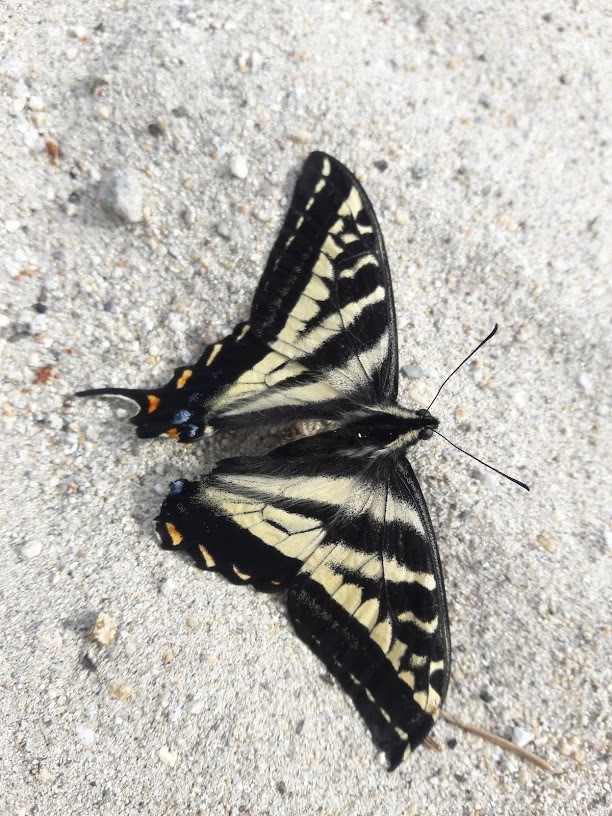Imagine a meadow of flowers: a kaleidoscope of colors with butterflies aflutter in all their prismatic splendor. Add a warm sunny day and it’s a picture of perfection; what more does a butterfly need? Depending on the type of butterfly, it may be looking for specific plants or locations.
50 species of butterflies can be found in Colorado
Roughly 50 species of butterflies can be found in Colorado, but there’s about 20,000 species flitting out and about in the world! The average life-span of an adult butterfly is about a month, with the smallest butterflies living for approximately a week and some butterflies up to 9 months! Despite being rather ephemeral creatures, butterflies have a significant impact on pollination, food chains, and other environmental factors. Keep your eyes open for these butterflies on your next frolic outdoors!
A butterfly you may be already familiar with is the monarch. Their notable feature is orange wings with black veins and white spots bordering the edge. Their most notable feat is their seasonal migration. Monarchs can travel up to 2,800 miles from the northeast United States to overwinter in central Mexico from early November to mid-March. Look for monarchs by milkweed since that is the sole food of monarch caterpillars until they metamorphosize into butterflies, at which point they can sample from a much wider array of wildflowers.
 Another easily recognizable butterfly is a swallowtail. There are a couple of different types, but I’ll describe a Western Tiger Swallowtail. This butterfly has yellow wings with four black stripes and a tail on each wing. You may also catch a glimpse of blue by the tail and the underside of the wings. You may also encounter several swallowtails huddling together at one spot. This behavior is called puddling and is common among many species of butterflies. A prime puddling site contains minerals like sodium, which supplements their diet of nectar. The Tiger Swallowtail caterpillars will munch on the leaves of the parsley family such as Queen Anne’s lace and carrots, while the adults will enjoy the nectar from red clover, milkweed and thistles.
Another easily recognizable butterfly is a swallowtail. There are a couple of different types, but I’ll describe a Western Tiger Swallowtail. This butterfly has yellow wings with four black stripes and a tail on each wing. You may also catch a glimpse of blue by the tail and the underside of the wings. You may also encounter several swallowtails huddling together at one spot. This behavior is called puddling and is common among many species of butterflies. A prime puddling site contains minerals like sodium, which supplements their diet of nectar. The Tiger Swallowtail caterpillars will munch on the leaves of the parsley family such as Queen Anne’s lace and carrots, while the adults will enjoy the nectar from red clover, milkweed and thistles.
 The Western Tiger Swallowtail butterfly has yellow wings with four black stripes
The Western Tiger Swallowtail butterfly has yellow wings with four black stripes
and a tail on each wing.
One group of butterflies with similar coloration to the monarchs are fritillaries. Fritillaries are also orange with black, but much smaller than monarchs and most will have silvery spots on the underside of the wings. These markings may help them with camouflaging while they are resting in sun dappled places. The checkered pattern of fritillaries is the reason for their common name which comes from a Latin word, fritillus, meaning chessboard. Many species of caterpillars have a very selective palate and for the fritillary caterpillar, their choice dish are violets. Sleeping through the winter, fritillaries will awaken in the spring with the sprouting of violets.

Fritillaries are much smaller than monarch butterflies and most will have silvery spots on the underside of the wings.
Butterflies are also important for studying the impacts of climate change
Butterflies have long-been enjoyed for their beauty, but they are also important for studying the impacts of climate change due to their high sensitivity to environmental fluctuations. Scientists have observed that many butterflies, including the monarchs, are shifting their ranges further north. Climate change affects the growing season which can drastically affect caterpillars dependent on one specific food source. The Chinese proverb - "The flapping of the wings of a butterfly can be felt on the other side of the world" - may have never been as directly pertinent to butterflies as it is now.
Butterflies are tied to our world in many ways and there’s ways we can help them. Planting natives and having spots where water can accumulate in our gardens provides a place for butterflies to replenish on nectar and water. Protecting and restoring our green spaces can lead to some positive environmental changes and have a butterfly effect, in a good way. Every step can help preserve that pretty picture of a meadow full of life and color.
Christina Nourmiev is a Naturalist with Walking Mountains Science Center. An entomology enthusiast, you can find her huddled by flowers looking for insects and chasing butterflies to add to her ever-growing gallery of nature photos.








